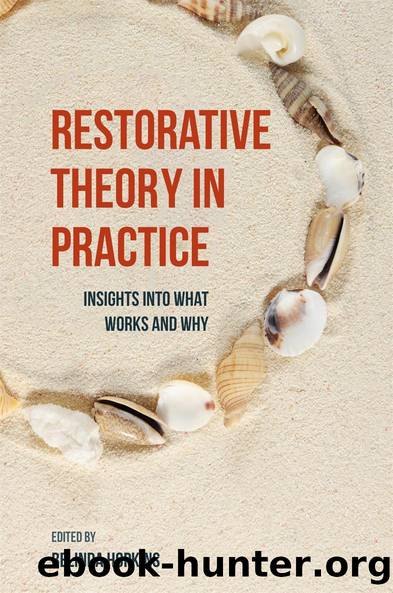Restorative Theory in Practice by Belinda Hopkins

Author:Belinda Hopkins [Hopkins, Belinda]
Language: eng
Format: epub
ISBN: 9781849054683
Barnesnoble:
Publisher: Kingsley, Jessica Publishers
Published: 2015-10-21T00:00:00+00:00
Shame
Throughout the restorative encounter I am keenly aware of the presence of shame. At no time, in my view, is the purpose of a restorative encounter to cause or create shame. But it is clear to me that people coming into the circle are carrying some level of shame, and that the circle is a vehicle for helping participants to process their shame and move beyond it.
I have found the topic of shame to be a stumbling block in almost all contexts. One possible reason is that attachment theory and at least some streams within the field of restorative justice understand shame differently. Attachment theory distinguishes clearly between shame and guilt. Consider the definition from renowned shame researcher Brené Brown (2010):
The majority of shame researchers and clinicians agree that the difference between shame and guilt is best understood as the differences between âI am badâ and âI did something badâ. Guilt = I did something bad. Shame = I am bad.
Shame is about who we are, and guilt is about our behaviors⦠Guilt is just as powerful as shame, but its effect is positive while shame often is destructive. When we see people apologize, make amends, or replace negative behaviors with more positive ones, guilt is often the motivator, not shame. In fact, in my research, I found that shame corrodes the part of us that believes we can change and do better. (2010, p.41, emphasis hers)
Along the lines of Brown, within the attachment framework, shame is only corrosive, paralysing. The goal working with children and youth with disorganised attachment is to move them from shame to guilt. Guilt brings with it a motivation to repair, whereas shame carries no such motivation. The presence of guilt means that enough of a sense of self has now been created that one is able to contemplate the possibility of repair.
Restorative justice theory has taken a different approach. Criminologist John Braithwaite proposed the distinction between âreintegrative shamingâ and âstigmatising, outcasting shamingâ, with reintegrative shaming having a positive effect. Braithwaite is clear that the aim of a restorative conference is never to shame (Harris, Walgrave and Braithwaite 2004). Costello, Wachtel and Wachtel (2009), building on the work of affect theorist Sylvan Tomkins (2008) and psychologist Donald Nathanson (1992), have argued that shame is both corrosive and motivational. Shame goads us to seek repair. In Tomkinsâ view, shame is an auxiliary affect; it requires first the presence of positive affects which shame interrupts (Nathanson 1992, p.138). Built into the experience of shame, therefore, is a desire to return to positive affect.
Living as I do in both the attachment and restorative practice worlds, and experiencing simultaneously the discordant sounds of these two incompatible notions of shame, I have struggled to find a resolution that will adequately comprehend the encounters with shame that I experience in both worlds. To that end, I propose, in the context of Nathansonâs larger view (1992) that shame is a fundamental regulator of human interaction, a differential understanding of shame that neither approach currently entertains or accepts.
Download
This site does not store any files on its server. We only index and link to content provided by other sites. Please contact the content providers to delete copyright contents if any and email us, we'll remove relevant links or contents immediately.
The 1921 Tulsa Race Massacre by Chris M. Messer(288)
Introduction to Criminal Justice - A Balanced Approach by Brian K. Payne Willard M. Oliver Nancy E. Marion(255)
Punishing the Poor The Neoliberal Government of Social Insecurity by Unknown(250)
Russia's Sakhalin Penal Colony, 1849â1917 by Andrew A. Gentes(249)
The History of Newgate Prison by Jowett Caroline;(236)
Serial Killers America and UK - 2 BOOKS IN 1 by Clark Matthew(211)
A History of Police and Masculinities, 1700-2010 by David G. Barrie Susan Broomhall(197)
Restorative Justice in Transitional Settings by Kerry Clamp(169)
Organized Crime and Corruption Across Borders by T. Wing Lo Dina Siegel Sharon I Kwok(159)
Culture, Crime and Punishment by Ronald Kramer(156)
Dangerousness, Risk and the Governance of Serious Sexual and Violent Offenders by Karen Harrison(156)
Cops, Cameras, and Crisis by Michael D. White Aili Malm(154)
Policing Gender, Class And Family In Britain, 1800-1945 by Linda Mahood(153)
Routledge Handbook on Immigration and Crime by Holly Ventura Miller Anthony Peguero(152)
The Real CSI by Kate Bendelow(150)
Women Exiting Prison by Bree Carlton Marie Segrave(144)
Losing Legitimacy by Gary Lafree(139)
Using Murder by Philip Jenkins(138)
A Theory of African American Offending by James D. Unnever Shaun L. Gabbidon(136)
